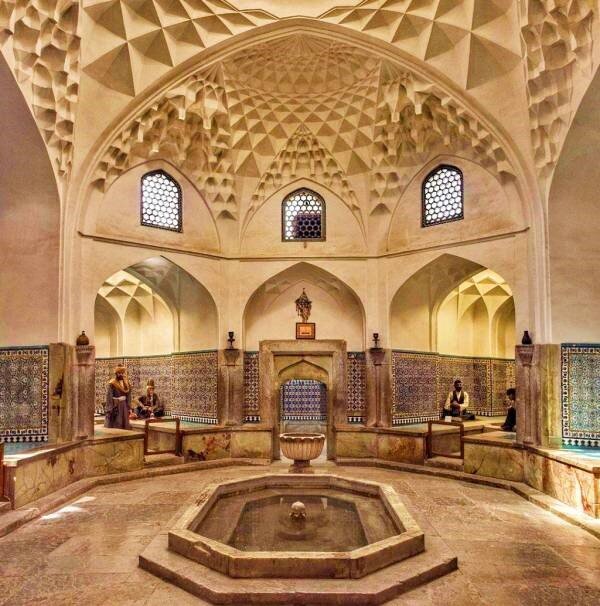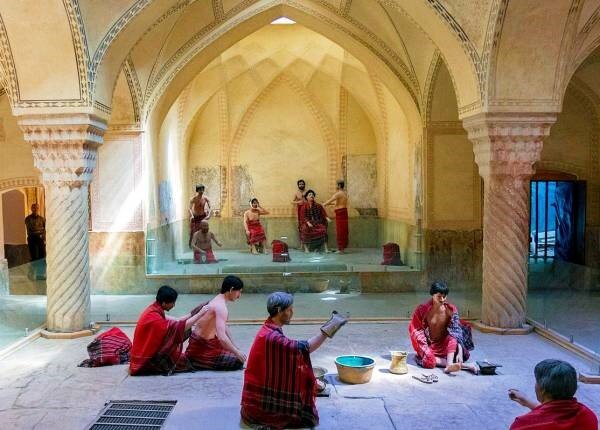By Seyed Hossein Hosseiniseddiq
Most people today have baths in their homes, but in the past, there were public baths that were not just for bathing but also a public place for family, social, business, and even political gatherings.
In the past, men would take a bath before sunrise until eight o’clock in the morning, and from that time until the afternoon, women would have a bath. Today, there are public baths in most parts of Iran, but the difference with the old baths is that a large hot water pool was used in the old baths; but in the new public baths, multiple showers have replaced the large hot tub, which did not conform to hygiene in any way.
It is interesting to know that washing in public baths had different etiquettes, which I will discuss in some of the customs of Iranian baths:
Archaeologists have concluded that the construction of public baths from the Achaemenid period, i.e. about three thousand years ago, has been common in all cities of Iran because the ancient Iranians, who had the Zoroastrian religion, took a bath to participate in the ceremony, in addition to cleansing body has been a religious ritual.
After the spread of Islam in Iran, it was obligatory to perform religious practices such as prayer and fasting and entering the mosque, bathing after sexual intercourse, and also after the end of menstruation in this religion. Even men sometimes prayed toward the Holy Cube in the bath before sunrise due to the short time of prayer after bathing. Therefore, the Persian kings ordered the construction of public baths in cities and villages. For example, during the Safavid era, in the early sixteenth century, only 272 public baths were built in the capital Isfahan.
One of the customs of bathing in the past was that everyone who entered the bath greeted the people who were washing.
After greeting, the person would take some of the water from the tub with a copper bowl and pour it on the shoulders of the people in the bath, whether familiar or unfamiliar, even showing more love and affection to strangers because they believed, friends and acquaintances do not need compliments.
Also, there was expressing politeness and respect by massaging. e.g. if the newcomer in the bath courtyard saw acquaintances or close relatives, would go toward them to show politeness and respect and give them a massage, or the person would forcibly take washcloth and soap from their hands and rub their back. There is an Iranian proverb that says about two very close friends that “they are friends in the bath and the garden.”
The role of baths in ancient times included:
-Baths were a public place for family gatherings and friendly.
- Some celebrations such as the bride and groom bath were held in these baths.
- Sometimes the baths became a place of quarrel or even assassination.
- Occasionally meetings and talks of government leaders were held in the bath.
- Baths have been the meeting place of elders, intellectuals and as a result of scientific debates and discussions between scholars, writers and scientists. Composing and reading poems in baths and reciting Shahnameh (a book of famous Persian epic poetry) has also been common. Verses from different poets have been installed on the walls of the baths.
- Baths also had functions for treatment. The existence of hot and cold water reservoirs is used to treat some diseases, and the bath is used in the past as a place of phlebotomy (venipuncture and cupping), colic and massage, removal of excess body hair, especially in the armpits and genital parts with special natural and traditional powder in a private room, sometimes men shaved their heads and applied henna.
- Baths were sometimes used as shelters, and some people who fled various social or political events took refuge in baths and were not persecuted like in other holy places.
Here is a brief overview of the architecture and components of an Iranian bath:
Baths were built next to mosques in all cities and villages of Iran and were opened before the morning call to prayer. The old baths were a few meters below the level of the alley and the corridor of the Bazaar to allow water to enter the big tub and also to protect it from the winter cold.

In the bath building, stone, brick, and a mixture of sand and lime mortar were used. The dressing room, hallway, and the hothouse were the main part of the Iranian bath, which was designed based on traditional Iranian and Islamic medicine.
Each of these three sections created three different atmospheres in terms of temperature, namely cold, warm and temperate. The building of the baths was designed based on four natures: hot, cold, dry, and wet. Each space was separated from the other spaces by a corridor and vestibule so that the temperature and humidity of each space did not suddenly change concerning its adjacent place and the air temperature did not drop suddenly.
The dressing room was a covered courtyard with a large pool in the middle and high platforms around which remove their clothes. There were poles around the locker rooms and colorful glass balls were hung on the poles. The master of the bath sat on one of those platforms or one of the platforms. A large lamp and sometimes chandelier hung from the roof of the dressing room above the pool. The air in the locker room was completely cold and dry and in traditional Iranian medicine was equivalent to autumn.
On a stool near the pool, they placed a large earthenware bowl containing plums and plum juice and several small bowls with wooden spoons, and in winter they poured beetroot juice with a little vinegar instead of plums and plum juice into that large bowl for use of customers.
The vestibule space between the locker room and the hothouse is equivalent to the winter season. This space is made of a small vestibule so that the heat and heat accumulated in the hothouse do not leave immediately and the person can enter the locker room with a delay from the hothouse.
The hothouse was octagonal or quadrangular with thick walls and a place for bathing and washing, with a hot water tank and a cold water tank. A metal plate with a diameter of 60 to 110 cm was placed in the bottom of the tub, which was the boundary between water and fire under the tub so that they always had hot and cold water. The temperament of this part was warmer and equivalent to spring. The roof of the hothouse was higher and in its main arch, there was a large hole that acted like a lighting system, which in Iranian architectural terms is called Goljam.
The fuel for baths in the past was desert thorns, firewood and animal dried defecation. Under the bathtub, there was a fireplace or a firebox, and a large copper vessel was placed under the floor of the tub, and a fire was lit under it so that the tub water would be warm during the night and warm for bathing in the early morning. Even in some baths architecture, such as Mehdi Qoli Beyk bath in Mashhad, which has built from the middle of the wall of one of the sides of the bath, a cold small water stream that runs directly from the Qanat or aqueduct for customers to drink while they are in the bath for a long time.
The main occupations of the bath
- Tontab: is the person who keeps the bath and bathwater warm and cleans the bath.
- Dallak, duty: washing, rubbing the body of customers by washcloth which made from rough fabrics or soft towel and sometimes massage to others
- Massager, task: massaging of people in bath
- Bath master, duty: the owner manages a private bath
- Bell boy or Pado, task: Arranging customers’ shoes and moving dry and wet slippers, giving “Long”, which is a special fabric that was given to customer men to tie it around their waist instead of shorts or briefs, but female customers usually were tying “Long” from the upper part their body to the knee. It is interesting to know that in the past, another of Pado’s tasks was to transfer rich men and women’s clothing baskets, copper bowls (to get water from the tub), and copper trays (usually used by women to sit on the bath floor) from their homes to the bath and sometimes the whole bath became private just for them.
- Horn, duty: blowing the horn at dawn and informing people that the bathwater is hot.
The most famous old baths:
- Ganjali Khan Bath in Kerman.
- Fin Bath in Kashan.
- Mehdi Qoli Beyk Bath in Mashhad.
- Qazi Bath in Gorgan.
- Golshan Bath in Lahijan.
- Khan Bath in Yazd.
- Ali Qoli Aqa Bath and Rehnan Bath in Esfahan.
- Vakil Bath in Shiraz.
- No or new (another name is Haaj Taqi) Bath in Shahroud.
Of course, nowadays most of these baths became to anthropology museum.


No comments:
Post a Comment